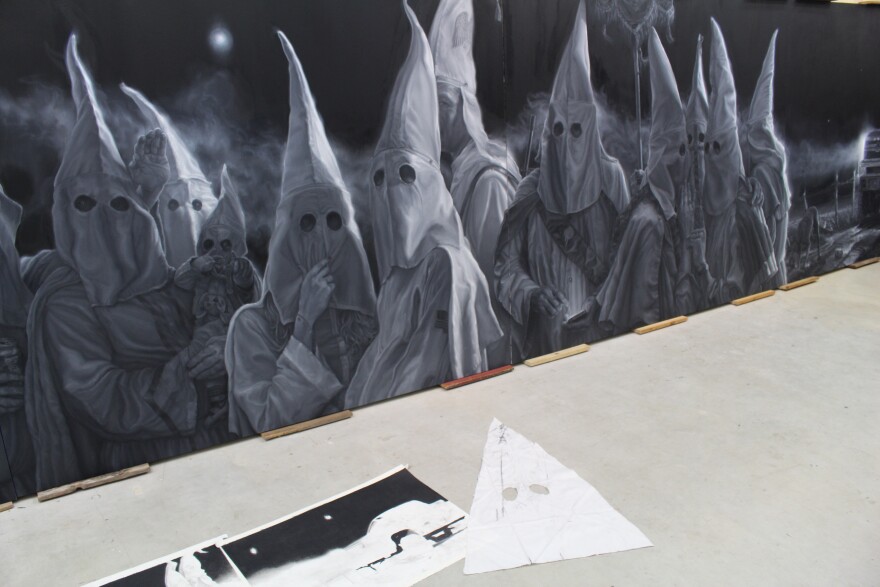Vincent Valdez’s art studio is in an old San Antonio fire station built in 1910. Above the entrance stands a vintage statue of a vigilant fire fighter clutching his ax.

Inside, the art space is taken over by one colossal black and white painting — 43 feet long — broken up into six panels. It’s titled “The City.” It features 14 hooded members of the Ku Klux Klan caught in a candid moment on a bluff overlooking a city at night.
“I felt that it was important that the viewer, when they first confront the piece, might even make the assumption that it is based on a historical photograph. That this is 1869 or 1920. But when they start looking at the details of the piece they’ll find traces of contemporary life like the iPhone, the baby Nikes, class rings, the cell phone towers and the modern day 21st century Chevrolet truck.”

Valdez started this painting last October. And after working on it seven days a week for 11 months, he says he’s glad it’s finally finished. But, he has been thinking about painting this image for years.
Valdez says viewers make the mistake in assuming it’s a reaction to the current political climate.
“People jump to the conclusion that this is Donald Trump’s fault – 'Oh, this is Trump all day right? This is about Trump.' Well, I ask the viewer to step back for a moment. You don’t have to look very far and you really don’t have to look too deep to realize that this was here – this was present – long before any politician,” Valdez says.
That’s not to say there isn’t a connection to today’s politics. There is a rise in white nationalism in American and in Europe. And according to the Southern Poverty Law Center there is a surge in the growth of white supremacist groups — especially the Ku Klux Klan.
“It’s strangely coincidental, fascinating. It strikes me as being a little bit surreal. I’m not sure what to make of it exactly. I guess all I can say about it is the timing couldn’t be more urgent,” he says.

When the painting, in its early stages, was featured in March in the New York Times, Valdez saw how he was touching a nerve in America.
“I was flooded with emails,” he said.
He says the majority of them were positive, but there were also some threats of violence against him.
One email wanted an apology from Valdez in a specific way.
“I know that you are the Texas State Artist of the Year and I demand that you wrap up your gold medal and hand it back to Texas Senator Ted Cruz,” it read.
However, Valdez points out that in his painting of the Klan gathering, the members aren’t doing anything that is evil or nefarious.
“They are just people. That was my opportunity to strip them of their power.”
They just stand there, staring into the eyes of the viewer. All but one is hooded. Even the infant being cradled in a mother’s arms in the center of the painting is wearing the iconic robe and pointed hood. But the baby’s cherub-like hands are reaching out to the viewer.

“This is definitely a statement reminding us all that this isn’t the way that we are born, right? This is something that is indoctrinated in us and something that is learned.”
On the day of this interview, “The City” was to leave the fire house. Valdez had finished the final touches at 4 a.m. the night before – working the details of the twinkling of the city’s lights. He signed the work. And now the specialty art movers are here to carefully pack up the panels and take them to the David Shelton Gallery in Houston.

Valdez says the arrival of these movers reminded him of another work crew that came to his studio and their reaction. They came into the studio and froze staring at the painting.
“He looks at me – and he looks at the painting – and he looks around at the building – he looks back at me and says – 'What is this place?! What are we doing here? What is it?' I said, 'No, no, trust me. I’m the artist. Come in, I can explain.' And it turned into one of the most amazing conversations.”
Valdez says that’s what he’s trying to do — get people to talk about race in America. And he said that is the power of art.








